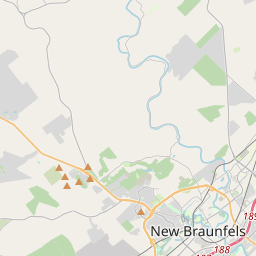Near River Crossing Used by New Braunfels' First Settlers
Historical marker location:






At the crossing of the San Antonio-Nacogdoches Road on the Guadalupe River (used earlier by some of Texas' most famous trail-blazers) about 200 German colonists ended a journey that had begun six months before, in Europe. Here, on Good Friday,1845, they founded the town of New Braunfels, named for the estate of Prince Solms-Braunfels, the commissioner-general of the German Emigration Society. Part of a wave of German colonists,1844-1847, this small group and others like it have left a distinctive mark on the heritage and culture of Texas. (1969)
As one of the most visible programs of the Texas Historical Commission (THC), historical markers commemorate diverse topics in Texas history, including: the history and architecture of houses, commercial and public buildings, religious congregations, and military sites; events that changed the course of local and state history; and individuals who have made lasting contributions to the state, community organizations, and businesses.
Texas was once a part of Mexico but gained independence in 1836 after a famous battle at the Alamo.
In the early 19th century, German immigrants began to arrive, attracted by the fertile land and opportunities for a better life. These settlers established small farming communities and brought with them their language, traditions, and expertise in agriculture and craftsmanship. The town of New Braunfels was founded in 1845 by Prince Carl of Solms-Braunfels, becoming the first German colony in Texas.
The mid-19th century saw significant growth and development in Comal County, with the construction of schools, churches, and businesses. The area became known for its thriving agricultural industry, with farmers cultivating crops such as cotton and corn. The arrival of the railroad in the late 19th century further spurred economic growth and provided easier access to markets.
Throughout the 20th century, Comal County continued to evolve and adapt to changing times. The county's strong German heritage remained at the forefront, celebrated through events like Wurstfest, a German sausage festival. The tourism industry also grew, with visitors flocking to the county's natural attractions, such as the iconic Guadalupe River and historic Gruene Hall, Texas' oldest continually operating dance hall.
Today, Comal County is a vibrant and thriving community, blending its rich history with modern amenities and a strong sense of pride in its cultural heritage. With its beautiful landscapes, strong economy, and warm Southern hospitality, Comal County continues to be a desirable place to live and visit.
Comal County Timeline
This timeline provides a condensed summary of the historical journey of Comal County, Texas.
- 1846 - Comal County established as one of the original 23 counties in the state of Texas
- 1847 - Settlement begins in the area with the founding of New Braunfels
- 1850 - Comal County's population reaches 2,013
- 1861-1865 - County residents actively involved in the American Civil War
- 1870 - Completion of the first railroad through Comal County
- 1885 - Jacob's Well, a natural artesian spring, becomes a popular tourist attraction
- 1920s - Economic growth in Comal County, driven by agriculture and manufacturing industries
- 1941-1945 - County residents contribute to the war effort during World War II
- 1968 - Canyon Lake, a reservoir on the Guadalupe River, is completed
- 1990s - Rapid population growth and urban development in Comal County
- 2007 - Construction begins on the controversial Trans-Texas Corridor project